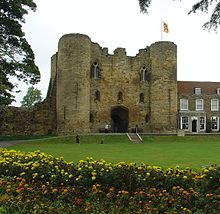Richard fitz Gilbert
Richard fitz Gilbert 1st Lord of Clare | |
|---|---|
| Hereditary | |
| Lord of the Honor of Clare | 1066-1090 |
| Successor | Gilbert fitz Richard |
| Born | 1035 Duchy of Normandy, France |
| Died | 1090 (aged 54–55) |
| Buried | St. Neot's Priory, Huntingdonshire, England |
| Family | de Clare |
| Spouse | Rohese Giffard |
| Issue | Walter de Clare, Lord of Nether Gwent Richard fitz Richard de Clare Roger fitz Richard de Clare Gilbert fitz Richard Robert fitz Richard Isabel de Clare Rohese de Clare Adelize de Clare |
| Father | Gilbert, Count of Brionne |

Richard fitz Gilbert (before 1035–c. 1090), 1st feudal baron of Clare[1] in Suffolk, was a Norman lord who participated in the Norman conquest of England in 1066, and was styled "de Bienfaite", "de Clare", and of "Tonbridge"[n 1][2] from his holdings.[3]
Biography
[edit]Richard was the son of Gilbert, Count of Brionne in Normandy[3] (Fitz was a variant spelling of the Norman filz, French fils, signifying "son of"). Gilbert was a guardian of the young duke William and when Gilbert was killed by Ralph de Wacy in 1040, his two older sons Richard and Gilbert fled to Flanders.[4] On his later return to Normandy Richard was rewarded with the lordship of Bienfaite and Orbec in Normandy.[4] In 1066, Richard came into England with his kinsman William the Conqueror, and received from him great advancement in honour and possessions.[3]
The Dictionary of National Biography and other sources are vague and sometimes contradictory about when the name de Clare came into common usage, but what we do know is that Richard fitz Gilbert (of Tonbridge), the earliest identifiable progenitor of the family, is once referred to as Richard of Clare in the Suffolk return of the Domesday Book.[5]
Rewards
[edit]He was rewarded with 176 manors in England, including the right to build castles at Clare in Suffolk, caput of his feudal barony, and at Tonbridge in Kent.[6] Some contemporaneous and later sources called him Earl of Clare, though many modern sources view the title as a "styled title".
He served as Joint Chief Justiciar in William's absence, and played a major part in suppressing the revolt of 1075.
Rebel baron
[edit]On the Conqueror's death, Richard and other great Norman barons, including Odo of Bayeux, Robert, Count of Mortain, and Geoffrey of Coutances, led a rebellion against the rule of William Rufus in order to place Robert Curthose on the throne. However, most Normans in England remained loyal.
Death and succession
[edit]He retired to a monastery in 1088, passing his possessions in England to his son Gilbert fitz Richard and his land in Normandy to his son Roger Fitz Richard.[7] He was buried in St. Neot's Priory in 1091. His widow was still living in 1113.
Marriage
[edit]Richard married Rohese Giffard, daughter of Walter Giffard, Lord of Longueville and Agnes Flaitel,[8] and they had at least the following children:
- Roger fitz Richard de Clare, received Norman lands and d. 1131.[8] Wife unknown, daughter Joanna married Gilbert de Neville.[9]
- Gilbert fitz Richard, d. 1115, succeeded his father as Earl of Clare.[8]
- Walter de Clare, Lord of Nether Gwent, d. 1138.[8]
- Richard fitz Richard de Clare, Abbot of Ely.[8]
- Robert fitz Richard,[8] Lord of Little Dunmow, Baron of Baynard, d. 1136.[10]
- Godfrey
- Alice (or Adeliza) de Clare, d. 1138. m. Gauthier de Corbeil - Tirell.
- Rohese de Clare, d. 1121, m. (ca. 1088), Eudo Dapifer.[8]
- Isabel de Clare, d. 1088, m. Humphrey d'Isle.
- Avice de Clare, m. Robert de Stafford / Tosny.[11][12]
Notes and references
[edit]Notes
[edit]- ^ Seen in the Domesday book variously as ""de Tonebridge/Tonebrige/Tonbridge"
References
[edit]- ^ Sanders, I.J. English Baronies: A Study of their Origin and Descent 1086-1327, Oxford, 1960, p.35
- ^ Domesday Map website - image of Betchworth's entry and transcription in summary Archived 2014-09-24 at the Wayback Machine retrieved 2012-10-30 Normally de Tonebridge in Surrey
- ^ a b c G. E. Cokayne, The Complete Peerage, Vol. III (The St. Catherine Press, London, 1913), p. 242
- ^ a b J.H. Round, 'The Family of Clare', The Archaeological Journal, Vol. 56 2nd series Vol 6 (1899), p. 224
- ^ The Suffolk return of the Domesday Survey (c. 1086) (ed. A. Rumble, Suffolk, 2 vols (Chichester, 1986), 67 ~ 1)
- ^ The Royal Ancestry Bible Royal ancestors of 300 American Families By Michel L. Call ISBN 1-933194-22-7 (chart 1696)
- ^ Frank Barlow, William Rufus (Berkeley & Los Angeles, University of California Press, 1983), p. 73
- ^ a b c d e f g Vaughn 2022, Appendix B.
- ^ https://digital.nls.uk/histories-of-scottish-families/archive/95661535#?c=0&m=0&s=0&cv=270&xywh=-6%2C870%2C2511%2C1741, p. 255
- ^ I.J. Sanders, English Baronies; A Study of their Origin and descent 1086-1327 (Oxford: The Clarendon Press, 1963), p. 129
- ^ Sir William Dugdale - Monasticon Anglicanum, Volume VI, Part I, Priory of Stone, page 231 - Link: Monasticon Anglicanum - Avice de Clare
- ^ Falconer Madan M.A. - The Gresleys of Drakelow, Toeni pedigree page 223 and Chapter 2, page 16 (Oxford, 1899)
Sources
[edit]- Vaughn, Sally N. (2022). Anselm of Bec and Robert of Meulan: The Innocence of the Dove and the Wisdom of the Serpent. University of California Press.
